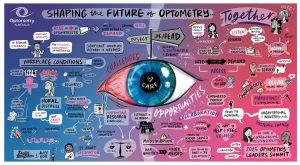1:30min
 Yesterday, many of optometry’s most influential leaders, researchers, educators and changemakers came together for Shaping the Future of Optometry Together, Optometry Australia’s inaugural Optometry Leaders’ Summit to explore solutions to the profession’s most pressing challenge: sustaining a robust workforce that meets Australia’s eye care needs now and into the future.
Yesterday, many of optometry’s most influential leaders, researchers, educators and changemakers came together for Shaping the Future of Optometry Together, Optometry Australia’s inaugural Optometry Leaders’ Summit to explore solutions to the profession’s most pressing challenge: sustaining a robust workforce that meets Australia’s eye care needs now and into the future.
The Summit served as a powerful forum for critical conversations shaped by new and confronting research – notably, the workforce conditions survey led by Flinders University and the national workforce projections study by the University of Queensland’s Centre for the Business and Economics of Health (CBEH).
The evidence is clear: Conditions and capacity must improve
Opening the Summit, Optometry Australia President Theo Charalambous reinforced the importance of timely, collective action to build a robust future for optometry. Presentations by Professor Nicola Anstice and the CBEH team laid bare a number of critical truths:
- The lived experience of many employee optometrists is marked by professional dissatisfaction.
- There is significant unmet population need for optometric care.
- There is currently an oversupply of optometrists to meet community demand for their services, but if demand is increased to match true population need for optometric care, the workforce will be insufficient.
The preliminary findings from Professor Anstice’s comprehensive national survey examining the working conditions of employed optometrists confirmed many anecdotal reports from optometrists nationally regarding workplace standards and systems. The initial findings reveal that, despite optometrists consistently delivering high-quality, evidence-based patient care, significant workplace reform is urgently needed to safeguard the integrity of clinical decision-making, safeguard patient and practitioner well-being, and facilitate fulfilling professional experiences.
In parallel, the 2025 Optometry Workforce Projections study highlighted that while optometry is currently in oversupply nationally, when compared to demand for eye care services, a stark gap exists between the number of optometrists currently practising and the number required to meet true population needs as we progress towards 2040 – especially when accounting for chronic disease burden, ageing demographics and inequities in access to care.
Turning talk into action
The summit’s collaborative sessions saw participants interrogate these findings and begin discussions to consider the pathway forward.
‘Our profession is not short on passion, purpose, or people who care deeply about the future of optometry – and the communities we serve,’ said Mr Charalambous in his closing remarks. ‘This Summit’s discussions have brought further clarity to our plans, and will continue to support our work, but we need leadership, at every level to build a future that works for optometrists and for the people who rely on us.’
Optometry Australia is committed to:
- Continuing to push for improved workplace conditions, and supporting the development of a strong, thriving workforce with the autonomy, training, and fulfilment to stay and grow in the profession.
- Strengthening our advocacy for expanded scope—including oral prescribing—because timely, effective care shouldn’t be hindered by outdated regulation.
- Elevating the value of optometry in the broader health system—so the public, and our policy makers, understand and invest in what we do, including through better integration with our public health systems.
- Chasing opportunities to better align community utilisation of services with population need for optometric care, including by pursuing evidence-backed approaches to address maldistribution of our optometry workforce.
Looking ahead
‘Today’s discussion was important,’ said OA CEO Skye Cappuccio. ‘But action is what counts. As leaders, we must accept a responsibility to act – together – to shape a thriving future for optometry.’